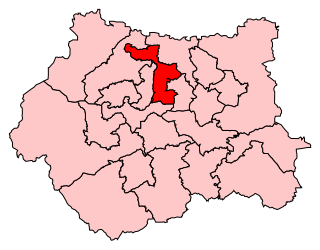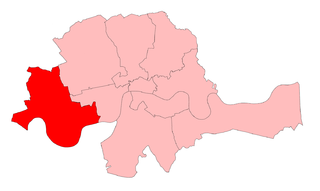Related Research Articles

The Representation of the People Act 1867, known as the Reform Act 1867 or the Second Reform Act, is an act of the British Parliament that enfranchised part of the urban male working class in England and Wales for the first time. It took effect in stages over the next two years, culminating in full commencement on 1 January 1869.

Pudsey was a constituency represented in the House of Commons of the UK Parliament.

Chelsea was a borough constituency, represented in the House of Commons of the Parliament of the United Kingdom.
Barkston Ash was a parliamentary constituency centred on the village of Barkston Ash in the West Riding of Yorkshire. It was represented in the House of Commons of the Parliament of the United Kingdom from 1885 until 1983. It elected one Member of Parliament (MP) by the first past the post system of election.
Buckrose was a county constituency of the House of Commons of the Parliament of the United Kingdom, comprising the northern part of the East Riding of Yorkshire, represented by one Member of Parliament, and was created for the 1885 general election.
Bradford was a parliamentary constituency in Bradford, in the West Riding of Yorkshire.

Cleveland was a county constituency in the Langbaurgh Wapentake, North Riding of Yorkshire, England.

West Riding of Yorkshire was a parliamentary constituency in England from 1832 to 1865. It returned two Members of Parliament (MPs) to the House of Commons of the Parliament of the United Kingdom.

Leeds was a parliamentary borough covering the town of Leeds, in the West Riding of Yorkshire, England. It was represented in the House of Commons of the Parliament of the United Kingdom from 1832 to 1885.

The East Riding of Yorkshire was a parliamentary constituency covering the East Riding of Yorkshire, omitting Beverley residents save a small minority of Beverley residents who also qualified on property grounds to vote in the county seat. It returned two Members of Parliament to the House of Commons of the Parliament of the United Kingdom. A brief earlier guise of the seat covered the changed franchise of the First Protectorate Parliament and Second Protectorate Parliament during a fraction of the twenty years of England and Wales existed as a republic.
South West Lancashire was a county constituency of the House of Commons of the Parliament of the United Kingdom. It was represented by two Members of Parliament. The constituency was created by the Reform Act of 1867 by the splitting of the South Lancashire constituency into new South-East and South-West divisions.
Knaresborough was a parliamentary constituency which returned two Members of Parliament (MPs) to the Parliament of England, Parliament of Great Britain and the House of Commons of the Parliament of the United Kingdom until 1868, and then one MP until its abolition in 1885.
Osgoldcross was a parliamentary constituency in the Osgoldcross Rural District of West Yorkshire. It returned one Member of Parliament (MP) to the House of Commons of the Parliament of the United Kingdom, elected by the first past the post system.
Northern West Riding of Yorkshire was a parliamentary constituency covering part of the historic West Riding of Yorkshire. It returned two Members of Parliament (MPs) to the House of Commons of the Parliament of the United Kingdom, elected by the bloc vote system.
Southern West Riding of Yorkshire was a parliamentary constituency covering part of the historic West Riding of Yorkshire. It returned two Members of Parliament (MPs) to the House of Commons of the Parliament of the United Kingdom, elected by the bloc vote system.
Liskeard was a parliamentary borough in Cornwall, which elected two Members of Parliament (MPs) to the House of Commons from 1295 until 1832, and then one member from 1832 until 1885. The constituency was abolished by the Redistribution of Seats Act 1885.
East Staffordshire or Staffordshire East was a county constituency in the county of Staffordshire. It returned two Members of Parliament (MPs) to the House of Commons of the Parliament of the United Kingdom, elected by the bloc vote system.
Mid Lincolnshire, formally called the Mid Division of Lincolnshire, was a county constituency in Lincolnshire. It returned two Members of Parliament (MPs) to the House of Commons of the Parliament of the United Kingdom, elected by the bloc vote electoral system.

South Lincolnshire, formally called the Southern Division of Lincolnshire or Parts of Kesteven and Holland, was a county constituency in Lincolnshire. It returned two Members of Parliament (MPs) to the House of Commons of the Parliament of the United Kingdom, elected by the bloc vote electoral system.
The ceremonial county of Cheshire, which comprises the unitary authorities of Cheshire East, Cheshire West and Chester, Halton and Warrington, has returned 11 MPs to the UK Parliament since 1997.
References
- ↑ "Representation of the People Act 1867" (PDF). Retrieved 23 May 2020.
- ↑ "A Collection of the Public General Statutes: 1867/68. Cap. XLVI. An Act to settle and describe the Limits of certain Boroughs and the Divisions of certain Counties in England and Wales, in so far as respects the Election of Members to serve in Parliament". London: Eyre and Spottiswoode. 1868. pp. 119–166. Retrieved 23 May 2020.
- 1 2 3 Craig, F. W. S., ed. (1977). British Parliamentary Election Results 1832-1885 (e-book) (1st ed.). London: Macmillan Press. p. 492. ISBN 978-1-349-02349-3.
- ↑ "The Elections West Riding Eastern Division". Yorkshire Post and Leeds Intelligencer. 28 November 1868.